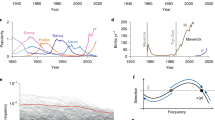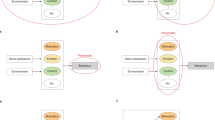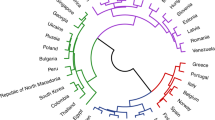Abstract
The covariance structure of personality traits derived from statistical models (for example, Big Five) is often assumed to be a human universal. Cross-cultural studies have challenged this view, finding that less-complex societies exhibit stronger covariation among behavioural characteristics, resulting in fewer derived personality factors. To explain these results, we propose the niche diversity hypothesis, in which a greater diversity of social and ecological niches elicits a broader range of multivariate behavioural profiles and, hence, lower trait covariance in a population. We formalize this as a computational model, which reproduces empirical results from recent cross-cultural studies and also yields an additional prediction for which we find empirical support. This work provides a general explanation for population differences in personality structure in both humans and other animals and suggests a substantial reimagining of personality research: instead of reifying statistical descriptions of manifest personality structures, research should focus more on modelling their underlying causes.
This is a preview of subscription content, access via your institution
Access options
Access Nature and 54 other Nature Portfolio journals
Get Nature+, our best-value online-access subscription
$29.99 / 30 days
cancel any time
Subscribe to this journal
Receive 12 digital issues and online access to articles
$119.00 per year
only $9.92 per issue
Buy this article
- Purchase on Springer Link
- Instant access to full article PDF
Prices may be subject to local taxes which are calculated during checkout





Similar content being viewed by others
Code availability
The Java code for the agent-based model, the SAS scripts used to perform the EFA and the R scripts used to generate our plots are all available on the Open Science Framework repository (https://osf.io/pyhq7/).
References
Ashton, M. C. & Lee, K. Empirical, theoretical, and practical advantages of the HEXACO model of personality structure. Pers. Soc. Psychol. Rev. 11, 150–166 (2007).
Buss, D. M. & Craik, K. H. The act frequency approach to personality. Psychol. Rev. 90, 105–126 (1983).
Fleeson, W. Toward a structure-and process-integrated view of personality: traits as density distributions of states. J. Pers. Soc. Psychol. 80, 1011–1027 (2001).
Mischel, W. & Shoda, Y. A cognitive–affective system theory of personality: reconceptualizing situations, dispositions, dynamics, and invariance in personality structure. Psychol. Rev. 102, 246–268 (1995).
Wood, D. & Denissen, J. J. in Psychology of Change: Life Contexts, Experiences, and Identities (eds Branscrombe, N. R. & Reynold, K.) 97–115 (Psychology Press, 2015).
John, O. P., Naumann, L. P. & Soto, C. J. in Handbook of Personality: Theory and Research 3rd edn (eds John, O. P. et al.) 114–158 (Guilford Press, 2008).
McCrae, R. R. & Costa, P. T.Jr. Personality trait structure as a human universal. Am. Psychol. 52, 509–516 (1997).
McCrae, R. R. & Costa, P. T. in The SAGE Handbook of Personality Theory and Assessment (eds Boyle, G. et al.) 273–294 (Sage, 2008).
Goldberg, L. R. The development of markers for the Big-Five factor structure. Psychol. Assess. 4, 26–42 (1992).
Bouchard, T. J. & Loehlin, J. C. Genes, evolution, and personality. Behav. Genet. 31, 243–273 (2001).
Nettle, D. Personality: What Makes You the Way You Are (Oxford Univ. Press, 2009).
Alvergne, A., Jokela, M. & Lummaa, V. Personality and reproductive success in a high-fertility human population. Proc. Natl Acad. Sci. USA 107, 11745–11750 (2010).
Bailey, D. H. et al. Heritability and fitness correlates of personality in the Ache, a natural-fertility population in paraguay. PLoS One 8, e59325 (2013).
Gurven, M., von Rueden, C., Massenkoff, M., Kaplan, H. & Lero Vie, M. How universal is the Big Five? Testing the five-factor of personality variation among forager–farmers in the Bolivian Amazon. J. Pers. Soc. Psychol. 104, 354–370 (2013).
Schmitt, D. P., Allik, J., McCrae, R. R., Benet-Martinez, V. & Ault, L. The geographic distribution of the Big Five personality traits: patterns and profiles of human self-description across 56 nations. J. Cross Cult. Psychol. 38, 173–212 (2007).
Saucier, G. et al. A basic bivariate structure of personality attributes evident across nine languages. J. Pers. 82, 1–14 (2014).
Schaller, M. & Murray, D. R. Pathogens, personality, and culture: disease prevalence predicts worldwide variability in sociosexuality, extraversion, and openness to experience. J. Pers. Soc. Psychol. 95, 212–221 (2008).
Schmitt, D. P., Realo, A., Voracek, M. & Allik, J. Why can’t a man be more like a woman? Sex differences in Big Five personality traits across 55 cultures. J. Pers. Soc. Psychol. 94, 168–182 (2008).
Baumert, A. et al. Integrating personality structure, personality process, and personality development. Eur. J. Pers. 31, 503–528 (2017).
Cramer, A. O. et al. Dimensions of normal personality as networks in search of equilibrium: you can’t like parties if you don’t like people. Eur. J. Pers. 26, 414–431 (2012).
Lukaszewski, A. W. Testing an adaptationist theory of trait covariation: relative bargaining power as a common calibrator of an interpersonal syndrome. Eur. J. Pers. 27, 328–345 (2013).
Uher, J. Personality psychology: lexical approaches, assessment methods, and trait concepts reveal only half of the story? Why it is time for a paradigm shift. Integr. Psychol. Behav. Sci. 47, 1–55 (2013).
Buss, D. M. Selection, evocation, and manipulation. J. Pers. Soc. Psychol. 53, 1214–1221 (1987).
De Vries, R. E., Tybur, J. M., Pollet, T. V. & van Vugt, M. Evolution, situational affordances, and the HEXACO model of personality. Evol. Hum. Behav. 37, 407–421 (2016).
Denissen, J. J. & Penke, L. Motivational individual reaction norms underlying the five-factor model of personality: first steps towards a theory-based conceptual framework. J. Res. Pers. 42, 1285–1302 (2008).
Montiglio, P.-O., Ferrari, C. & Réale, D. Social niche specialization under constraints: personality, social interactions and environmental heterogeneity. Phil. Trans. R. Soc. B 368, 20120343 (2013).
Kagan, J. in Social Anxiety 3rd edn (eds Hofman, S. G. & DiBartolo, P. M.) 377–418 (Elsevier, 2014).
von Rueden, C. R., Lukaszewski, A. W. & Gurven, M. Adaptive personality calibration in a human society: effects of embodied capital on prosocial traits. Behav. Ecol. 26, 1071–1082 (2015).
Jokela, M., Pekkarinen, T., Sarvimäki, M., Terviö, M. & Uusitalo, R. Secular rise in economically valuable personality traits. Proc. Natl Acad. Sci. USA 114, 6527–6532 (2017).
Quinlan, R. J., Dira, S. J., Caudell, M. & Quinlan, M. Culture and psychological responses to environmental shocks. Curr. Anthropol. 57, 632–652 (2016).
Sng, O., Neuberg, S. L., Varnum, M. E. & Kenrick, D. T. The behavioral ecology of cultural psychological variation. Psychol. Rev. 125, 714–743 (2018).
Nettle, D. in The Evolution of Personality and Individual Differences (eds Buss, D. M. & Hawley, P. H.) 5–28 (Oxford Univ. Press, 2011).
Schoener, T. in The Princeton Guide to Ecology (eds Levin, S. A. et al.) 3–13 (Princeton Univ. Press, 2009).
Pocheville, A. in Handbook of Evolutionary Thinking in the Sciences (eds Heams, T. et al.) 547–586 (Springer, 2015).
Lukaszewski, A. W., Gurven, M., von Rueden, C. R. & Schmitt, D. P. What explains personality covariation? A test of the socioecological complexity hypothesis. Soc. Psychol. Pers. Sci. 8, 943–952 (2017).
Smaldino, P. E. Social identity and cooperation in cultural evolution. Behav. Process. 161, 108–116 (2019).
Halverson, C. F. et al. Personality structure as derived from parental ratings of free descriptions of children: the inventory of child individual differences. J. Pers. 71, 995–1026 (2003).
Gopnik, A., Griffiths, T. L. & Lucas, C. G. When younger learners can be better (or at least more open-minded) than older ones. Curr. Dir. Psychol. Sci. 24, 87–92 (2015).
Sih, A. et al. Animal personality and state–behaviour feedbacks: a review and guide for empiricists. Trends Ecol. Evol. 30, 50–60 (2015).
Bergmüller, R. & Taborsky, M. Animal personality due to social niche specialisation. Trends Ecol. Evol. 25, 504–511 (2010).
Araújo, M. S., Bolnick, D. I. & Layman, C. A. The ecological causes of individual specialisation. Ecol. Lett. 14, 948–958 (2011).
Webster, M. M. & Ward, A. J. Personality and social context. Biol. Rev. 86, 759–773 (2011).
Stamps, J. & Groothuis, T. G. The development of animal personality: relevance, concepts and perspectives. Biol. Rev. 85, 301–325 (2010).
Michelangeli, M., Chapple, D. G., Goulet, C. T., Bertram, M. G. & Wong, B. Behavioral syndromes vary among geographically distinct populations in a reptile. Behav. Ecol. 30, 393–401 (2018).
Denissen, J. J. et al. Uncovering the power of personality to shape income. Psychol. Sci. 29, 3–13 (2018).
Bleidorn, W. et al. Personality maturation around the world: a cross-cultural examination of social-investment theory. Psychol. Sci. 24, 2530–2540 (2013).
Hudson, N. W., Roberts, B. W. & Lodi-Smith, J. Personality trait development and social investment in work. J. Res. Pers. 46, 334–344 (2012).
Roberts, B. W., Wood, D. & Smith, J. L. Evaluating five factor theory and social investment perspectives on personality trait development. J. Res. Pers. 39, 166–184 (2005).
Nowak, A., Vallacher, R. R. & Zochowski, M. The emergence of personality: dynamic foundations of individual variation. Dev. Rev. 25, 351–385 (2005).
McElreath, R. & Strimling, P. How noisy information and individual asymmetries can make ‘personality’ an adaptation: a simple model. Anim. Behav. 72, 1135–1139 (2006).
Dubois, F., Giraldeau, L.-A. & Réale, D. Frequency-dependent payoffs and sequential decision-making favour consistent tactic use. Proc. R. Soc. B 279, 1977–1985 (2012).
Lake, M. W. & Crema, E. R. The cultural evolution of adaptive-trait diversity when resources are uncertain and finite. Adv. Complex Syst. 15, 1150013 (2012).
Vásárhelyi, Z., Meszéna, G. & Scheuring, I. Evolution of heritable behavioural differences in a model of social division of labour. PeerJ 3, e977 (2015).
Wolf, M., Van Doorn, G. S., Leimar, O. & Weissing, F. J. Life-history trade-offs favour the evolution of animal personalities. Nature 447, 581–584 (2007).
Wolf, M. & McNamara, J. M. On the evolution of personalities via frequency-dependent selection. Am. Nat. 179, 679–692 (2012).
Gurven, M. D. Broadening horizons: sample diversity and socioecological theory are essential to the future of psychological science. Proc. Natl Acad. Sci. USA 115, 11420–11427 (2018).
Gelfand, M. J. et al. Differences between tight and loose cultures: a 33-nation study. Science 332, 1100–1104 (2011).
Hofstede, G. Cultures and Organizations: Software of the Mind (McGraw-Hill, 1991).
House, R. J, Hanges, P. J, Javidan, M, Dorfman, P. W. & Gupta, V. Culture, Leadership, and Organizations: The GLOBE Study of 62 Societies (Sage, 2004).
Bartram, D. Scalar equivalence of OPQ32: Big Five profiles of 31 countries. J. Cross Cult. Psychol. 44, 61–83 (2013).
Caspi, A., Roberts, B. W. & Shiner, R. L. Personality development: stability and change. Annu. Rev. Psychol. 56, 453–484 (2005).
MacLean, K. A., Johnson, M. W. & Griffiths, R. R. Mystical experiences occasioned by the hallucinogen psilocybin lead to increases in the personality domain of openness. J. Psychopharmacol. 25, 1453–1461 (2011).
Contreras Kallens, P. A., Dale, R. & Smaldino, P. E. Cultural evolution of categorization. Cogn. Syst. Res. 52, 765–774 (2018).
Buss, D. M. in The Evolution of Personality and Individual Differences (eds Buss, D. M. & Hawley, P. H.) 29–57 (Oxford Univ. Press, 2011).
Wood, D. Testing the lexical hypothesis: are socially important traits more densely reflected in the English lexicon? J. Pers. Soc. Psychol. 108, 317–335 (2015).
Van Valen, L. Morphological variation and width of ecological niche. Am. Nat. 99, 377–390 (1965).
Hill, K. & Hurtado, A. M. Aché Life History: The Ecology and Demography of a Foraging People (Routledge, 2017).
Haldane, J. B. S. A defense of beanbag genetics. Perspect. Biol. Med. 7, 343–360 (1964).
Smaldino, P. E. in Computational Social Psychology (eds Vallacher, R. R. et al.) 311–331 (Routledge, 2017).
Healy, K. Fuck nuance. Sociol. Theory 35, 118–127 (2017).
Muthukrishna, M. & Henrich, J. A problem in theory. Nat. Hum. Behav. 3, 221–229 (2019).
Brewer, M. B. The social self: on being the same and different at the same time. Pers. Soc. Psychol. Bull. 17, 475–482 (1991).
Berger, J. & Heath, C. Who drives divergence? Identity signaling, outgroup dissimilarity, and the abandonment of cultural tastes. J. Pers. Soc. Psychol. 95, 593–607 (2008).
Krause, J., James, R. & Croft, D. Personality in the context of social networks. Phil. Trans. R. Soc. B 365, 4099–4106 (2010).
McPherson, M., Smith-Lovin, L. & Cook, J. M. Birds of a feather: homophily in social networks. Annu. Rev. Sociol. 27, 415–444 (2001).
Frankenhuis, W. E. & Panchanathan, K. Balancing sampling and specialization: an adaptationist model of incremental development. Proc. R. Soc. B 278, 3558–3565 (2011).
Panchanathan, K. & Frankenhuis, W. E. The evolution of sensitive periods in a model of incremental development. Proc. R. Soc. B 283, 20152439 (2016).
Frankenhuis, W. E., Panchanathan, K. & Belsky, J. A mathematical model of the evolution of individual differences in developmental plasticity arising through parental bet-hedging. Dev. Sci. 19, 251–274 (2016).
Smaldino, P. E. & Richerson, P. J. The origins of options. Front. Neurosci. 6, 50 (2012).
Heyes, C. Cognitive Gadgets: The Cultural Evolution of Thinking (Harvard Univ. Press, 2018).
Flache, A. & Macy, M. W. Small worlds and cultural polarization. J. Math. Sociol. 35, 146–176 (2011).
Turner, M. A. & Smaldino, P. E. Paths to polarization: how extreme views, miscommunication, and random chance drive opinion dynamics. Complexity 2018, 2740959 (2018).
Rescorla, R. A. & Wagner, A. R. in Classical Conditioning II: Current Research and Theory (eds Black, A. H. & Prokasy, W. F.) 64–99 (Appleton-Century-Crofts, 1972).
Sutton, R. S. & Barto, A. G. Reinforcement Learning (MIT Press, 1998).
Epstein, J. M Agent_Zero: Toward Neurocognitive Foundations for Generative Social Science (Princeton Univ. Press, 2014).
Smaldino, P. E. & Epstein, J. M. Social conformity despite individual preferences for distinctiveness. R. Soc. Open Sci. 2, 140437 (2015).
Acknowledgements
We thank audiences at UC Merced and MPI-EVA for discussion of these ideas, and B. Beheim, J. Bunce, J. Chung, E. Fried, A. Kandler, D. Lukas, J. Rohrer, B. Roberts and M. Turner for helpful comments on earlier drafts of this manuscript. The authors received no specific funding for this work.
Author information
Authors and Affiliations
Contributions
P.E.S., A.L., C.v.R. and M.G. designed the research plan. P.E.S. built and analysed the computational model. M.G. analysed the empirical data and performed the EFA on the simulated data. P.E.S., A.L., C.v.R. and M.G. wrote the manuscript.
Corresponding authors
Ethics declarations
Competing interests
The authors declare no competing interests.
Additional information
Peer review information Primary handling editor: Stavroula Kousta.
Publisher’s note Springer Nature remains neutral with regard to jurisdictional claims in published maps and institutional affiliations.
Supplementary information
Supplementary Information
Supplementary Results, Supplementary Discussion, Supplementary Figs. 1–5 and Supplementary Tables 1–3.
Rights and permissions
About this article
Cite this article
Smaldino, P.E., Lukaszewski, A., von Rueden, C. et al. Niche diversity can explain cross-cultural differences in personality structure. Nat Hum Behav 3, 1276–1283 (2019). https://doi.org/10.1038/s41562-019-0730-3
Received:
Accepted:
Published:
Issue Date:
DOI: https://doi.org/10.1038/s41562-019-0730-3
This article is cited by
-
Universality, domain-specificity and development of psychological responses to music
Nature Reviews Psychology (2023)
-
Evolutionary Psychology and Normal Science: in Search of a Unifying Research Program
Integrative Psychological and Behavioral Science (2023)
-
On the Usefulness of Behavior Genetics: Using Family Studies in Evolutionary Psychological Science to Improve Causal Inference and Sharpen Theory
Adaptive Human Behavior and Physiology (2023)
-
The cultural evolution of emotion
Nature Reviews Psychology (2022)
-
Measurement Issues in Tests of the Socioecological Complexity Hypothesis
Evolutionary Psychological Science (2022)



